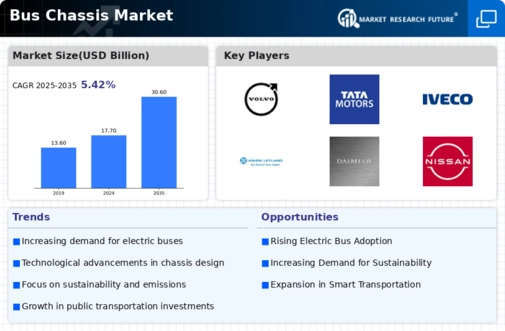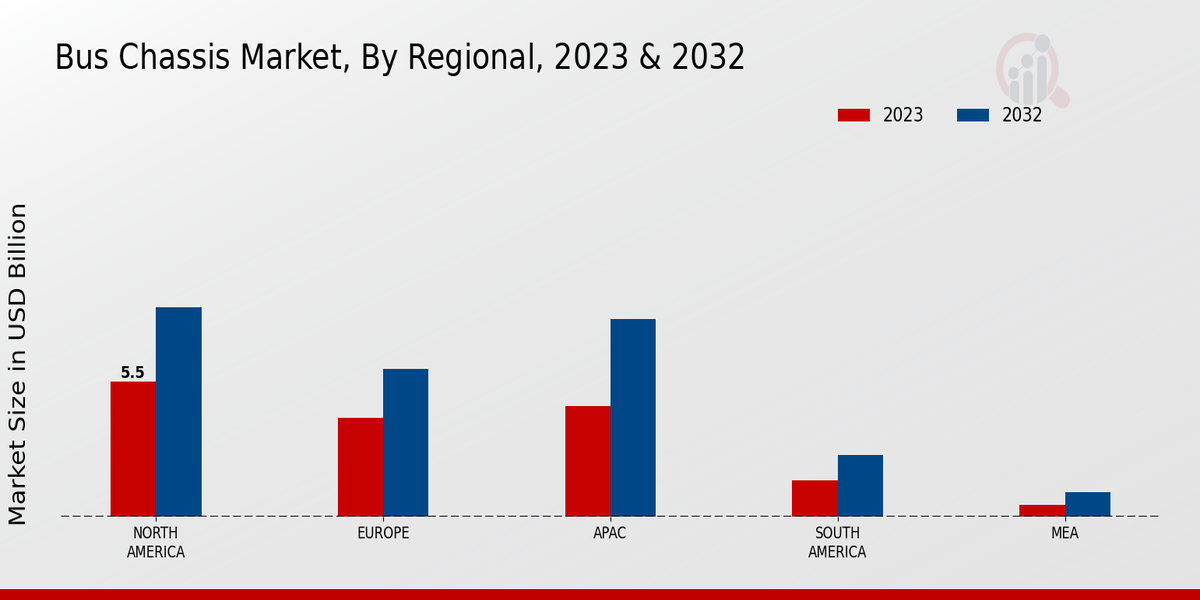Growing Urbanization
The rapid pace of urbanization across the globe is a primary driver of the Global Bus Chassis Market Industry. As cities expand, the demand for public transportation increases, necessitating the development of efficient bus systems. In 2024, the market is projected to reach 17.7 USD Billion, reflecting the urgent need for reliable bus chassis to support urban transit. Governments are investing in public transport infrastructure to alleviate traffic congestion and reduce environmental impact. This trend is expected to continue, with the market anticipated to grow as urban populations rise, leading to a projected market size of 30.6 USD Billion by 2035.
Technological Advancements
Technological innovations in bus chassis design and manufacturing are significantly influencing the Global Bus Chassis Market Industry. Advancements such as lightweight materials, enhanced safety features, and improved fuel efficiency are becoming increasingly prevalent. These innovations not only enhance the performance of buses but also contribute to sustainability efforts. For instance, the integration of electric and hybrid technologies is gaining traction, aligning with global efforts to reduce carbon emissions. As these technologies evolve, they are likely to attract investment and drive market growth, contributing to a projected CAGR of 5.08% from 2025 to 2035.
Market Trends and Projections
The Global Bus Chassis Market Industry is characterized by various trends and projections that indicate a positive growth trajectory. The market is expected to reach 17.7 USD Billion in 2024, with a significant increase to 30.6 USD Billion by 2035. This growth is underpinned by a compound annual growth rate (CAGR) of 5.08% from 2025 to 2035. Factors such as urbanization, technological advancements, and government initiatives are driving this expansion. The increasing focus on sustainability and the adoption of electric buses further contribute to the market's favorable outlook, suggesting a dynamic and evolving industry landscape.
Rising Demand for Public Transport
The increasing demand for public transport solutions is a significant factor driving the Global Bus Chassis Market Industry. As populations grow and urban areas become more congested, the need for efficient public transport systems becomes more pronounced. This demand is further fueled by a shift in consumer preferences towards sustainable transport options. Consequently, bus manufacturers are focusing on developing chassis that can accommodate various types of buses, including electric and hybrid models. This trend is expected to support the market's growth trajectory, with projections indicating a market size of 30.6 USD Billion by 2035.
Government Initiatives and Regulations
Government initiatives aimed at promoting public transportation and reducing vehicular emissions are pivotal to the Global Bus Chassis Market Industry. Many countries are implementing stricter emission regulations and providing incentives for the adoption of cleaner technologies. These policies encourage manufacturers to innovate and produce eco-friendly bus chassis. For example, several nations are investing in electric bus fleets, which require specialized chassis designs. Such regulatory frameworks not only support environmental goals but also stimulate market growth, as manufacturers adapt to meet new standards and consumer expectations.
Emerging Markets and Infrastructure Development
Emerging markets are witnessing substantial infrastructure development, which is a key driver of the Global Bus Chassis Market Industry. Countries in Asia, Africa, and Latin America are investing heavily in transportation infrastructure to support economic growth and improve mobility. This investment leads to an increased demand for bus chassis as new transit systems are established. The expansion of urban areas in these regions creates opportunities for bus manufacturers to introduce innovative chassis solutions. As infrastructure projects progress, the market is likely to experience robust growth, contributing to a projected CAGR of 5.08% from 2025 to 2035.
























